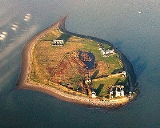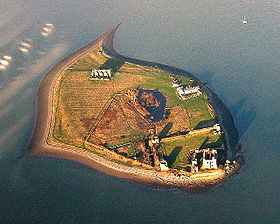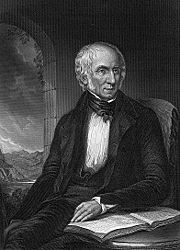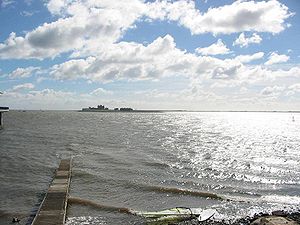
Piel Island
Encyclopedia

Furness
Furness is a peninsula in south Cumbria, England. At its widest extent, it is considered to cover the whole of North Lonsdale, that part of the Lonsdale hundred that is an exclave of the historic county of Lancashire, lying to the north of Morecambe Bay....
Peninsula in the administrative county
Administrative county
An administrative county was an administrative division in England and Wales and Ireland used for the purposes of local government. They are now abolished, although in Northern Ireland their former areas are used as the basis for lieutenancy....
of Cumbria
Cumbria
Cumbria , is a non-metropolitan county in North West England. The county and Cumbria County Council, its local authority, came into existence in 1974 after the passage of the Local Government Act 1972. Cumbria's largest settlement and county town is Carlisle. It consists of six districts, and in...
, though historically within Lancashire
Lancashire
Lancashire is a non-metropolitan county of historic origin in the North West of England. It takes its name from the city of Lancaster, and is sometimes known as the County of Lancaster. Although Lancaster is still considered to be the county town, Lancashire County Council is based in Preston...
north of the sands. It is located at 54°4′N 3°10′W (OS
British national grid reference system
The Ordnance Survey National Grid reference system is a system of geographic grid references used in Great Britain, different from using latitude and longitude....
grid ref. SD 233637). It is one of the Islands of Furness
Islands of Furness
The Islands of Furness are situated to the south-west and east of the Furness Peninsula. Within England, they are the third biggest collection of islands. They are generally quite small, though at 12.99 km2 Walney Island is the 8th biggest in England. Of these, only Walney Island, Barrow...
in Northern England
Northern England
Northern England, also known as the North of England, the North or the North Country, is a cultural region of England. It is not an official government region, but rather an informal amalgamation of counties. The southern extent of the region is roughly the River Trent, while the North is bordered...
. It is the location of the English Heritage
English Heritage
English Heritage . is an executive non-departmental public body of the British Government sponsored by the Department for Culture, Media and Sport...
-owned Piel Castle
Piel Castle
Piel Castle also known as Fouldry Castle, is a castle situated on the south-eastern point of Piel Island, 1 km off the southern tip of the Furness Peninsula, protecting the deep water harbour of Barrow-in-Furness in north west England.....
.
The island is owned by the people of Barrow-in-Furness
Barrow-in-Furness
Barrow-in-Furness is an industrial town and seaport which forms about half the territory of the wider Borough of Barrow-in-Furness in the county of Cumbria, England. It lies north of Liverpool, northwest of Manchester and southwest from the county town of Carlisle...
, the mainland town across the Piel Channel within whose administrative boundaries it is to be found. Gifted to the people of Barrow-in-Furness by the Duke of Buccleuch in the early 20th century, the island is kept in order by the Borough Council, whose duties also include the selection of the "King" of Piel, who is the landlord of the island's public house, the Ship Inn. The area of Piel is about 50 acres (20 ha). As well as the landlord and his family the island has two other permanent residents who live in the old Pilots Cottages. The Ship Inn is once again open for business, as the new "King" has taken residence.
History

Middle Ages
The Middle Ages is a periodization of European history from the 5th century to the 15th century. The Middle Ages follows the fall of the Western Roman Empire in 476 and precedes the Early Modern Era. It is the middle period of a three-period division of Western history: Classic, Medieval and Modern...
Piel was known as Fowdray (or Fouldrey or Fowdrey) island. This name would seem to be derived from the Old Norse
Old Norse
Old Norse is a North Germanic language that was spoken by inhabitants of Scandinavia and inhabitants of their overseas settlements during the Viking Age, until about 1300....
words of "fouder" meaning fodder, and "ay" or "oy" meaning island. The island's known history dates from the time of King Stephen
Stephen of England
Stephen , often referred to as Stephen of Blois , was a grandson of William the Conqueror. He was King of England from 1135 to his death, and also the Count of Boulogne by right of his wife. Stephen's reign was marked by the Anarchy, a civil war with his cousin and rival, the Empress Matilda...
who, in 1127 gave the island to the Savignac
Savignac
Savignac is the name of several communes in France:* Savignac, Aveyron, in the Aveyron department* Savignac, Gironde, in the Gironde departmentAlso, the monastic order:* Congregation of Savigny...
monks as part of a land grant for an abbey. When the Savignacs became part of the Cistercian order later in the 12th century, the island came under the control of the Cistercians at nearby Furness Abbey
Furness Abbey
Furness Abbey, or St. Mary of Furness is a former monastery situated on the outskirts of the English town of Barrow-in-Furness, Cumbria. The abbey dates back to 1123 and was once the second wealthiest and most powerful Cistercian monastery in the country, behind only Fountains Abbey in North...
. In the early 13th century the Cistercians used Piel as a safe harbour and built a warehouse for the storage of grain, wine and wool. Some of these commodities were shipped over from Ireland
Ireland
Ireland is an island to the northwest of continental Europe. It is the third-largest island in Europe and the twentieth-largest island on Earth...
. In 1212 the monks were granted a licence by King John
John of England
John , also known as John Lackland , was King of England from 6 April 1199 until his death...
to land one cargo of "wheat, flour and other provisions" to stave off a famine caused by the failure of the local harvest. Later in the century an unlimited cargo licence was granted and in 1258 ships owned by the abbey were placed under royal protection.
The monks fortified the island, firstly with a wooden tower surrounded by a ditch with palisades, and then in 1327 they commenced the building of a motte and bailey fort. This structure was, at the time, the largest of its kind in North West England
North West England
North West England, informally known as The North West, is one of the nine official regions of England.North West England had a 2006 estimated population of 6,853,201 the third most populated region after London and the South East...
. It was probably built as a fortified warehouse to repel pirates and raiders, but it would appear to have had a measure of success in keeping the customs men at bay as well; smuggling was widespread at the time and the abbey was known to have been involved. Indeed, in 1423 an accusation was made against the Abbott of Furness that he smuggled wool out of the country from "la Peele de Foddray". The red sandstone
Sandstone
Sandstone is a sedimentary rock composed mainly of sand-sized minerals or rock grains.Most sandstone is composed of quartz and/or feldspar because these are the most common minerals in the Earth's crust. Like sand, sandstone may be any colour, but the most common colours are tan, brown, yellow,...
ruins of the fort came to be known as the "Pile of Fouldrey", and are known today as Piel Castle
Piel Castle
Piel Castle also known as Fouldry Castle, is a castle situated on the south-eastern point of Piel Island, 1 km off the southern tip of the Furness Peninsula, protecting the deep water harbour of Barrow-in-Furness in north west England.....
.

Lambert Simnel
Lambert Simnel was a pretender to the throne of England. His claim to be the Earl of Warwick in 1487 threatened the newly established reign of King Henry VII .-Early life:...
and his supporters arrived from Dublin. Simnel was being passed off as Edward VI
Edward VI of England
Edward VI was the King of England and Ireland from 28 January 1547 until his death. He was crowned on 20 February at the age of nine. The son of Henry VIII and Jane Seymour, Edward was the third monarch of the Tudor dynasty and England's first monarch who was raised as a Protestant...
, King of England by John de la Pole, Earl of Lincoln in his attempt to regain the throne for the Yorkists. Simnel and 2,000 German
Germany
Germany , officially the Federal Republic of Germany , is a federal parliamentary republic in Europe. The country consists of 16 states while the capital and largest city is Berlin. Germany covers an area of 357,021 km2 and has a largely temperate seasonal climate...
mercenaries made their way via Piel to do battle for the throne. They were eventually defeated at the Battle of Stoke near Newark-on-Trent
Newark-on-Trent
Newark-on-Trent is a market town in Nottinghamshire in the East Midlands region of England. It stands on the River Trent, the A1 , and the East Coast Main Line railway. The origins of the town are possibly Roman as it lies on an important Roman road, the Fosse Way...
in Nottinghamshire
Nottinghamshire
Nottinghamshire is a county in the East Midlands of England, bordering South Yorkshire to the north-west, Lincolnshire to the east, Leicestershire to the south, and Derbyshire to the west...
on 16 June 1487.
A Customs Creek
Following the Dissolution of the MonasteriesDissolution of the Monasteries
The Dissolution of the Monasteries, sometimes referred to as the Suppression of the Monasteries, was the set of administrative and legal processes between 1536 and 1541 by which Henry VIII disbanded monasteries, priories, convents and friaries in England, Wales and Ireland; appropriated their...
in 1537 Piel Island and its castle became the property of the king. The castle's fortifications were strengthened at the time of the Spanish Armada
Spanish Armada
This article refers to the Battle of Gravelines, for the modern navy of Spain, see Spanish NavyThe Spanish Armada was the Spanish fleet that sailed against England under the command of the Duke of Medina Sidonia in 1588, with the intention of overthrowing Elizabeth I of England to stop English...
but from then until the Civil War
English Civil War
The English Civil War was a series of armed conflicts and political machinations between Parliamentarians and Royalists...
nothing of note happened on the island. The area of Furness was a Parliamentarian
Parliament of England
The Parliament of England was the legislature of the Kingdom of England. In 1066, William of Normandy introduced a feudal system, by which he sought the advice of a council of tenants-in-chief and ecclesiastics before making laws...
stronghold during the Civil War. For this reason the Parliamentarian fleet retreated to Piel Harbour when the Royalists
Cavalier
Cavalier was the name used by Parliamentarians for a Royalist supporter of King Charles I and son Charles II during the English Civil War, the Interregnum, and the Restoration...
captured Liverpool
Liverpool
Liverpool is a city and metropolitan borough of Merseyside, England, along the eastern side of the Mersey Estuary. It was founded as a borough in 1207 and was granted city status in 1880...
.
In 1662, following the restoration of Charles II, the lordship of Furness was given to the Duke of Albemarle
George Monck, 1st Duke of Albemarle
George Monck, 1st Duke of Albemarle, KG was an English soldier and politician and a key figure in the restoration of Charles II.-Early life and career:...
and this included the castle and parts of the island. After this date activity on Piel seems to have revolved around shipping and industry. A salt works is recorded as existing on the island from as early as 1662, which was still apparently present in the 1690s.
Piel Island became an important trading post during the 18th century and customs men were permanently stationed there; smuggling was still rife at the time. In the second half of the 18th century the iron ore trade began to develop on the Furness Peninsula and the harbour continued to be important to the local economy. As the volume of shipping increased "His Majesty's boatmen" were stationed on Piel as harbour pilots and customs inspectors. Their cottages still stand, now used as summer residences by sailors.
In formal terms, it was a creek (outstation) of the port of Lancaster
Lancaster, Lancashire
Lancaster is the county town of Lancashire, England. It is situated on the River Lune and has a population of 45,952. Lancaster is a constituent settlement of the wider City of Lancaster, local government district which has a population of 133,914 and encompasses several outlying towns, including...
, and known as Piel Foudray.
In the 19th century the island was the subject of a poem by romanticist
Romantic poetry
Romanticism, a philosophical, literary, artistic and cultural era which began in the mid/late-1700s as a reaction against the prevailing Enlightenment ideals of the day , also influenced poetry...
William Wordsworth
William Wordsworth
William Wordsworth was a major English Romantic poet who, with Samuel Taylor Coleridge, helped to launch the Romantic Age in English literature with the 1798 joint publication Lyrical Ballads....
.
Piel Island eventually fell under the ownership of the Duke of Buccleuch
Duke of Buccleuch
The title Duke of Buccleuch , formerly also spelt Duke of Buccleugh, was created in the Peerage of Scotland on 20 April 1663 for the Duke of Monmouth, who was the eldest illegitimate son of Charles II of Scotland, England, and Ireland and who had married Anne Scott, 4th Countess of Buccleuch.Anne...
. He donated it to the people of Barrow-in-Furness in 1920 as a World War I
World War I
World War I , which was predominantly called the World War or the Great War from its occurrence until 1939, and the First World War or World War I thereafter, was a major war centred in Europe that began on 28 July 1914 and lasted until 11 November 1918...
memorial.
Modern day Piel Island

Roa Island
Roa Island lies just over half a mile south of the village of Rampside at the southernmost point of the Furness Peninsula in Cumbria, though formerly in the area of Lancashire north of the sands. It is located at . It is one of the Islands of Furness in northern England. It has an area of about...
by the Piel Channel, the island is accessible via a ferryboat which runs from Roa Island pier during summer weekends. A causeway links the island to Walney Island
Walney Island
The Isle of Walney, also known as Walney Island, is an island in the United Kingdom which lies off the west coast of England, at the northern tip of Morecambe Bay. It forms part of the Borough of Barrow-in-Furness, and it is separated from the mainland at Barrow by Walney Channel, a narrow channel...
but is only passable with care at low tide. Piel Castle is managed by English Heritage
English Heritage
English Heritage . is an executive non-departmental public body of the British Government sponsored by the Department for Culture, Media and Sport...
and there is free, unlimited access. The castle, located on the southeast tip of Piel Island, is an impressive ruin made up largely of stones from the beach. The three-storey keep affords spectacular views of the island although, sadly, is no longer accessible to visitors, though campers may pitch a tent in its shadows.
The island is a haven for wildlife with many different species of sea bird to be found. Visitors should take care not to disturb nesting birds while walking on the beach. A marsh pond in the centre of the island now attracts many other types of bird.
The Ship Inn
The Ship Inn dates from the late 18th century. Today it provides sustenance for sailors, fishermen and day-tripperDay-tripper
A day-tripper is a person who visits a tourist destination or visitor attraction from his/her home and returns home on the same day.- Definition :In other words, this excursion does not involve a night away from home such as experienced on a holiday...
s to the island. The landlord is known as 'The King of Piel', a title originating from the time of Lambert Simnel and his attempt to usurp the English throne. A tradition associated with the pub is known as the 'Knighthood of Piel'. Local fishermen have handed this down over the centuries. In a room of the inn is a large oak chair and anyone who sits in it is made a 'Knight of Piel'. The ceremonial knighting is carried out by the King of Piel or a fellow knight. The present day cost of becoming a knight is to buy a round of drinks for all those present. However, the privilege afforded to knights is that they may demand food and lodging off the innkeeper should they be shipwrecked on Piel.
The pub's licence ended in November 2005 and Rod Scarr, who had been King of Piel for 20 years, left the island in April 2006. The island thus fell under the control of Barrow Borough Council. The opportunity was taken to fully renovate the pub, though work did not begin until July 2008, shortly before the new 'King of Piel', Steve Chattaway, was crowned (an event that was documented in the TV series Islands of Britain
Islands of Britain (TV series)
Islands of Britain was a 2009 documentary , hosted by Martin Clunes, that visited a number of the islands that lie off the coast of Great Britain.-Episode 1: The North:...
.
The origins of the Ship Inn are obscure, and although it is said to be over 300 years old the evidence for this is uncertain. In 1746 a lease for agricultural land situated within the castle ditch was granted to an Edward Postlethwaite, who is described as an innkeeper from the ‘Pile of Fowdrey’. The earliest direct reference to an inn, or ‘publick house’ is only in 1800. In 1813 a visitor paints a vivid picture of the life of the innkeeper at that time:
The earliest map reference, in 1833, refers to the inn as 'The Herdhouse', and the first person who can confidently be identified as a landlord of the Ship Inn is James Hool as he is listed in the 1841 census as a publican.

